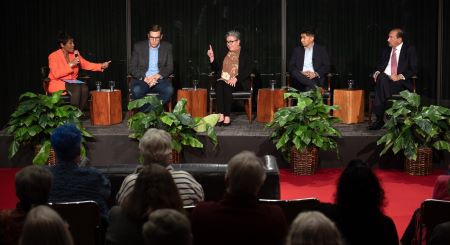Rational Middle Immigration Documentary Series Continues With "Lines and Limitations"
 The filmmakers at the Rational Middle are working hard to bust the myths around the immigration debate. As you might imagine, it is no easy task in the current environment with an election unfolding as President Trump points to a caravan of migrants making their way to the United States from Central America.
The filmmakers at the Rational Middle are working hard to bust the myths around the immigration debate. As you might imagine, it is no easy task in the current environment with an election unfolding as President Trump points to a caravan of migrants making their way to the United States from Central America.
In their latest episode, Director Gregory Kallenberg, Executive Producer Loren Steffy and their film crew explore the challenges of entering the United States legally. After pointing out that US immigration law is only surpassed in complexity by tax law, the team works to make crystal clear the hurdles faced by workers and others doing their best to enter following the rules.
The sixth film in the series, called “Lines and Limitations,” gets down into the weeds of the four main ways immigration to this nation occurs:
Family Reunification
Employment
Refugees and Asylum Seekers
The Diversity Lottery
Jill Campbell, Managing Immigration Attorney at Baker Ripley in Houston, explained the green card process and detailed many of the reasons a person might be turned away.
“That is where your background, your criminal history, your immigration history, are all evaluated to find out if you are admissible," Campbell said. She said Homeland Security looks at "every little thing about you" and then checks it against databases globally. "The process of doing a background check just to come over as a refugee could take three years easy," Campbell said.
"I guess the law is not meant to make sense,” Campbell said. “The law is just meant to restrict who comes to the United States."
"The point here is that to enter the country legally is one of limited opportunity," said Ali Noorani, Executive Director of the National Immigration Forum. "To go through the multiple steps necessary...is incredibly difficult."
Director of Immigration and Cross-Border Policy at the Bipartisan Policy Center Theresa Cardinal Brown said "even if there's a line that you theoretically can get into, how many people are gonnna wait 20 or 30 years for a visa?" That is often the case, depending on which country a person is trying to leave for the US.
"If you're in really desperate straits, that's not really a viable means for you to try to come in,” Cardinal Brown said.
Tony Payan, Director of the Mexico Center at Rice University in Houston, disputed the idea that immigrants should just “get in line with everyone else,” as some folks often argue. “Well, they don't realize that, for them, there is no line,” Payan said.
While the inscription on the Statue of Liberty reads "Give me your tired, your poor, your huddled masses yearning to breathe free,” Payan said a better reflection of current immigration law would be an inscription reading "Give me your relatives. Then give me your engineers and your scientists.”
"Poor people have no path to come into this country (legally),” Payan said.
The entire series of videos, thus far, is available here.








